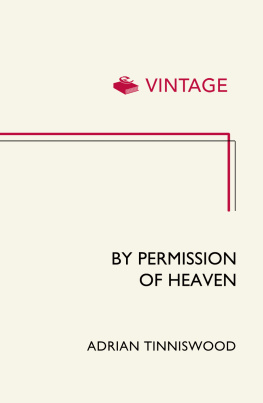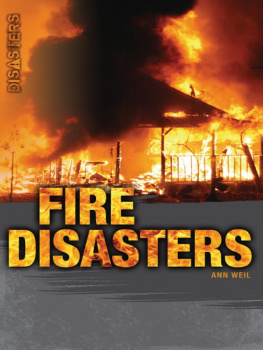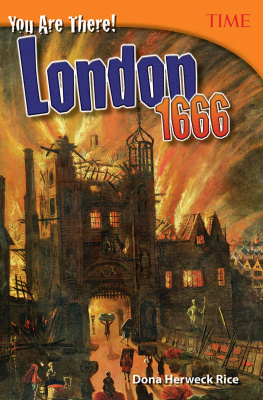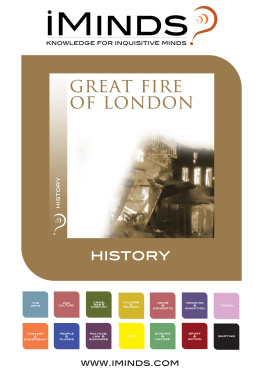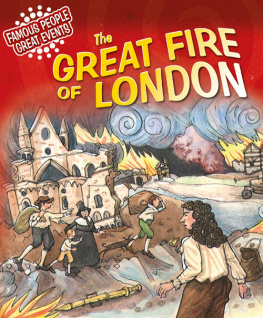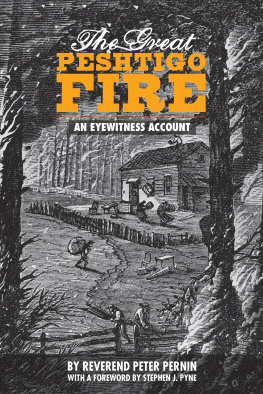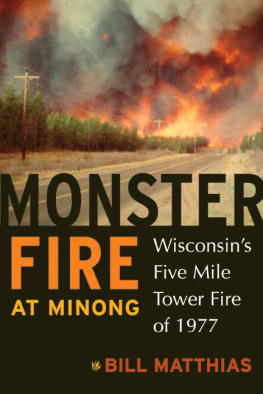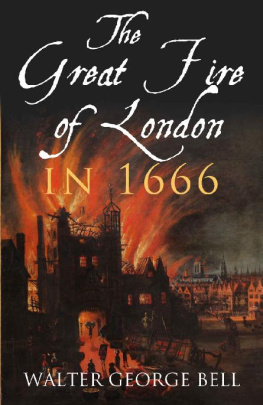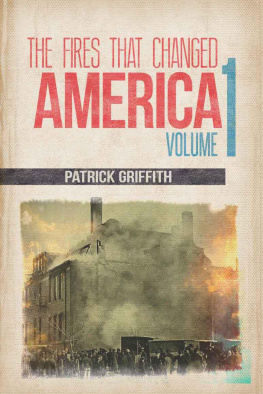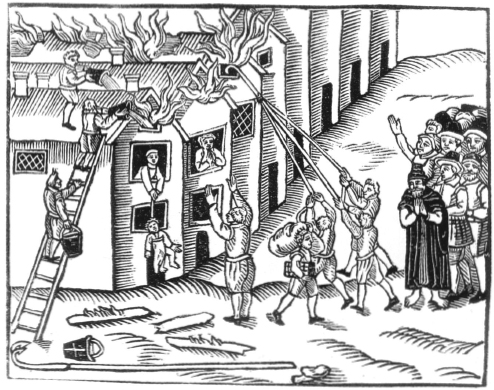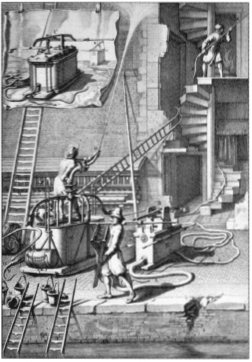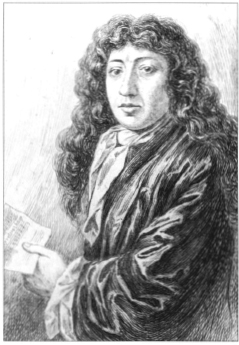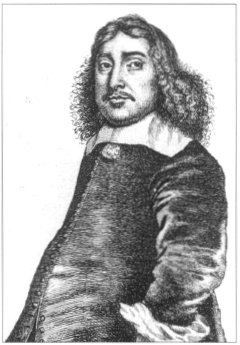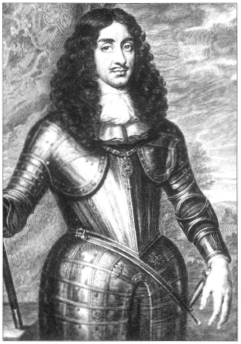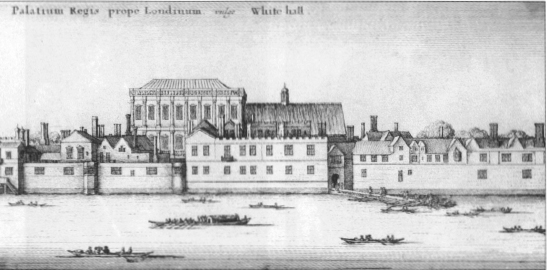Contents
About the Book
There had, of course, been other fires. Four hundred and fifty years before, the city had almost burned to the ground. Yet the signs from the heavens in 1666 were ominous: comets, pyramids of flames, monsters born in city slums. Then in the early hours on September, a small fire broke out on the ground floor of a bakers house in Pudding Lane. In five days that small fire would devastate the third largest city in the Western world.
Adrian Tinniswoods magnificent new account of the Great Fire of London explores the history of a cataclysm and its consequences. It pieces together the untold human story of the Fire and its aftermath the panic, the search for scapegoats, the rebirth of a city. Above all, it provides an unsurpassable recreation of what happened to schoolchildren and servants, courtiers and clergymen when the streets of London ran with fire.
About the Author
Adrian Tinniswood is a historian and educationalist. He lectures regularly in Britain and the USA, and was for many years consultant to the National Trust on heritage education. He is the author of eleven previous books on social and architectural history, including The Polite Tourist: A History of Country House Visiting, Visions of Power: Ambition and Architecture, and, most recently, His Invention So Fertile, his acclaimed biography of Sir Christopher Wren, also published in Pimlico.
By Permission of Heaven
The Story of the Great Fire of London
Adrian Tinniswood

This ebook is copyright material and must not be copied, reproduced, transferred, distributed, leased, licensed or publicly performed or used in any way except as specifically permitted inwriting by the publishers, as allowed under the terms and conditions under which it was purchased or as strictly permitted by applicable copyright law. Any unauthorised distribution or use of this text may be a direct infringement of the authors and publishers rights and those responsible may be liable in law accordingly.
Epub ISBN: 9781446402719
Version 1.0
www.randomhouse.co.uk
Published by Pimlico 2004
2 4 6 8 10 9 7 5 3
Copyright Adrian Tinniswood 2003
Adrian Tinniswood has asserted his right under the Copyright, Designs and Patents act 1988 to be indentified as the author of this work
First published in Great Britain by Jonathan Cape 2003
Pimlico edition 2004
Pimlico
Random House, 20 Vauxhall Bridge Road,
London SW1V 2SA
Random House UK Limited Reg. No. 954009
A CIP catalogue record for this book is available from the British Library
ISBN 9780712668477
For Kevin
Acknowledgements
Many people have helped me with this book. I owe a particular and personal debt of gratitude to my agents Felicity Bryan and Irene Skolnick, who between them have managed to shield me from harm and enrich my life (a combination which is hard to beat); to Dan Franklin at Jonathan Cape, who first suggested that I might like to write about the Great Fire of London; to Tristan Jones, whose editorial skills with a manuscript are positively alchemical; to Tricia Lankester, whose comments and suggestions have, as always, been more helpful and encouraging than I can say; to Kevin Simpson, who understands the psychology of the Fire so well, and understands his old friend even better; and to Martin Sparkes, without whom my working life would have been a lot more painful.
Id like to pay tribute to the students and friends who did so much to clarify my thoughts on the seventeenth century during a series of seminars at Merton College, Oxford, in the summer of 2002; to Barry Gillions of the Paul Hamlyn Foundation; to map-maker Reginald Piggott and indexer Douglas Matthews; and to the staff at the many libraries Ive haunted in the course of my research, including the Bodleian, the British Library, the Guildhall Library and the London Library. I am especially grateful to the library staff at Bristol University, who have borne the brunt of my enquiries over the last couple of years; time after time, their calm efficiency, unfailing kindness and superhuman patience have left me lost in wonder and admiration. I must also acknowledge a debt to past historians of the Fire, who have made my work so much easier than it might have been; and particularly to the late Walter George Bell, whose works on Restoration London created a standard of lucidity by which all historians of the period will be judged.
Last, first, always, thanks to Helen.
Bath, June 2003
1. Hell breaks loose on the capital of England in this nightmarish Allegory of London by a follower of Jan II Breughel. The painting in the foreground shows the execution of Charles I, while the City burns in the distance.
2. Buckets and fire-hooks being used to fight a fire at Tiverton in Devon in 1612.
3. Seventeenth-century fire engines in action. At the time of the Great Fire, hoses like those shown here were still a thing of the future.
4. Samuel Pepys.
5. George Monck, 1st Duke of Albemarle.
6. Charles II.
7. James, Duke of York.
8. Westminster from the Thames, with (from left to right) the Parliament House, Westminster Hall and the Abbey (Wenceslaus Hollar).
9. The river frontage of the Palace of Whitehall (Wenceslaus Hollar). The complex is dominated by Inigo Joness Banqueting Hall, one of the most admired buildings in England in the 1660s.
10. Sir Christopher Wren, painted in 1711 by Sir Godfrey Kneller. A plan of St Pauls Cathedral is draped over the table.
11. The Royal Exchange on Cornhill, Londons cathedral of commerce and the retail hub of the City (Wenceslaus Hollar).
Next page
